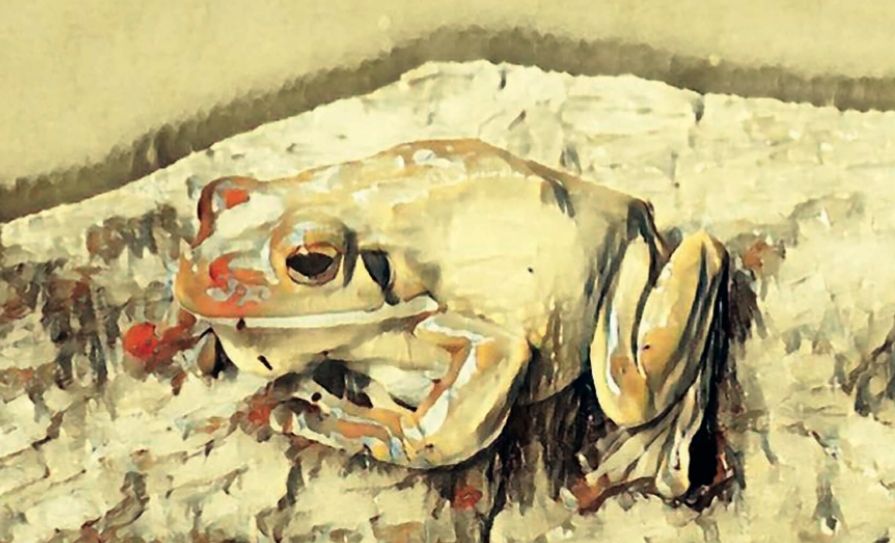Terry Maguire considers giving Kambo a go
This New Year, I am treating myself to a Kambo Healing Ritual, because I’m worth it, and I feel I need it. In the early days of December as the temperature plummeted and the light faded, who didn’t feel a bit down, or frankly depressed. It was then that I first became aware of Kambo on social media, with a surprising focus on Belfast. Belfast is not normally ahead of the curve when adopting the new, but I read the endorsements and I said to myself, this is exactly what we all need.
Well-known local social media influencers were posting how “down in the dumps” they were one day and then, a few days later, they popped up again to tell us “how wonderful their lives had become” and claiming it was all down to Kambo. Taking part in a Kambo Healing Ritual, these trend-setters claim, resets you to a more positive way of being. And if you are really interested, you too can become a Kambo practitioner by completing a short, intense training programme for as little as £600.
Kambo, for those who are so out of touch they don’t yet know, is a healing ritual from South America. It uses the poisonous secretions of the giant monkey frog (Phyllomedusa bicolor). This kindly frog produces the slimy mucus secretions, central to the ritual, through its skin. It normally produces a lot of this stuff when scared witless. Funny thing is, I think this green frog has been staring out at me for years from the cover of my much-loved 1980 copy of David Attenborough’s Life on Earth. But then again, I might be wrong, as the dust cover only identifies that species as ‘Tree Frog, Panama’ with no proper Linnaean name. As I will point out, its vital to get the right frog.
Nature has selected this pretty frog for its uncanny ability to secrete bioactive proteins that are highly toxic to predators who would otherwise eat it. In the Amazon, the frog normally does this when frightened and this includes when being tied by the legs between two tree branches by a burley Amazonian Indian tribesman while he scrapes the resultant gunge off its skin with a fashioned piece of bamboo. The claim that afterwards he releases the frog unharmed fails to dispel my concerns for the wellbeing of this rare amphibian.
It might seem strange to many of us, given the toxicity of this gooey mucus, that humans are willing to apply it to their own bodies for its alleged health benefits. Yet for centuries the indigenous peoples of the Amazon forest, we are told, have used Kambo to heal, cleanse and strengthen their bodies, also believing it to increase stamina and hunting skills.
Despite little research, proponents of kambo are convinced it can help with a range of conditions, including addiction, anxiety, depression and chronic pain, to mention but a few.
The ritual is somewhat bizarre, requiring a commitment not normally associated with those who dabble with ‘party drugs’. Water is drunk to hydrate, then a trained practitioner burns a number of holes on the skin around the shoulder area or ankle and the burns turn to blisters. The blistered skin is cut off and the kambo applied and, in this way, it gets into the lymphatic system and the bloodstream. Side-effects can be immediate and are expected, especially facial swelling, vomiting, diarrhoea and abdominal cramps but once these effects begin to fade, in about five-to-30 minutes, the patient is given more fluid so they don’t dehydrate. That seems to be it. A doctor would probably diagnose these expected symptoms as anaphylaxis and rush the patient off to hospital, but no, this apparently is the healing process.
The active ingredients of Kambo are bioactive peptides and have been studied scientifically since the 1960s. So far, 16 peptides have been isolated. Transferring the ritual of stone-age Amazonian tribes to modern-day natural healers’ front rooms first happened in Australia, where the focus was on ‘healing’ and ‘cleansing’ of body, emotions and spirit. Not really sure what that means.
Getting skin mucus from the right frog is vital, as many species of frogs inhabiting the dense jungle of the Amazon do the same trick of producing toxic mucus but of a more deadly nature, and two deaths in Chile associated with using the wrong frog mucus have been recorded.
Also, some patients drink too much water before and after the ritual and this too can be fatal, as happened to a 44-year-old woman in Slovenia taking part in a Kambo ritual and who drank six litres of water. Some of the bioactive peptides have a direct effect on blood pressure and water retention and can cause significant effects on these important body regulatory systems.
The after-effects described as enhanced stamina and better hunting skills might be a result of dermorphine, caerulein or deltorphin peptides, each with analgesic properties and an affinity for the opiate receptors, and this might explain Kambo’s use more recently in pain management.
The ritual is somewhat bizarre, requiring
a commitment not normally associated with those who dabble in ‘party drugs’
The mucus is applied as small nodular dots — snots — to the ‘burns gates’, as the practitioners call them and does not seem to have any true dosage control, and that must be a worry, as many of these peptides in high doses will kill. That said, and given the expanding modern use of Kambo, it is surprising that we are not seeing more reports of adverse incidents. If you suffer from a cardiovascular condition, mental disease or are pregnant, you certainly should not take part in a Kambo ritual; if you do, you are asking for trouble.
There is an emerging literature of adverse events and hospitalisations from Kambo rituals across the globe as this new health fad takes hold.Two deaths in Australia have been blamed on Kambo. Natasha Lechner died from a suspected cardiac event, while Jarrad Antonovich died after injuries from severe vomiting. But there is no research proving its supposed health benefits.
Natasha, a 39-year-old, was morbidly obese and had turned to alternative medicines to manage chronic back pain. During a Kambo ritual, within seconds of applying Kambo to five small burns on her chest and arm, she passed out. Minutes later, she was dead.
Jarrad Antonovich’s death on 16 October 2021 was more prolonged. Paramedics called to the ritual were “shooed away” from Mr Antonovich by a woman who accused them of interfering with his “aura”, the inquest in the NSW Coroner’s Court heard.
It was suggested to the paramedics that Mr Antonovich was suffering from an asthma attack. In reality, his oesophagus had ruptured, such was the force of vomiting.
Australia made Kambo illegal in 2021; it is listed it as a Schedule 10 poison, the highest possible danger classification for medicines and chemicals.
UK proponents of Kambo claim that, unlike in Australia, Kambo is not illegal in the UK. I would politely wish to disagree. Kambo contains two bioactive peptides, dermorphine and deltorphin, that make it illegal to supply and administer under the Psychoactive Substances Act 2016. So, no need to make new legislation to stop this practice.
But before busybodies make it a matter of urgency to clamp down on Kambo rituals, and before Belfast becomes the first place in the UK to have a Kambo death, I’m planning to give it a go!
Terry Maguire owns two pharmacies in Belfast. He is an honorary senior lecturer at the School of Pharmacy, Queen’s University Belfast. His research interests include the contribution of community pharmacy to improving public health.







